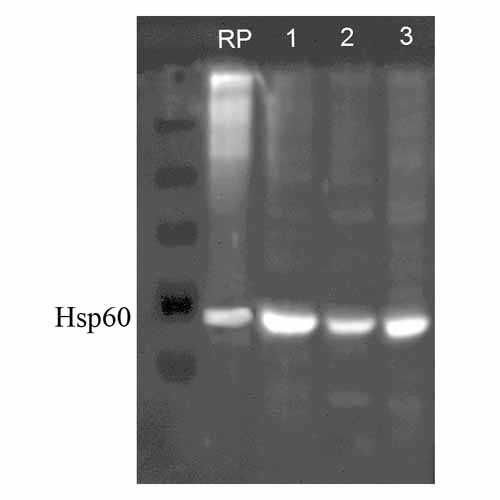HSP60 Antibody
- SPECIFICATION
- CITATIONS
- PROTOCOLS
- BACKGROUND

Application
| WB, IHC, IP |
|---|---|
| Primary Accession | P10809 |
| Other Accession | NP_002147.2 |
| Host | Rabbit |
| Reactivity | Human, Mouse, Rat, Rabbit, Chicken, Bovine, Dog |
| Clonality | Polyclonal |
| Description | Rabbit Anti-Human HSP60 Polyclonal |
| Target/Specificity | Detects ~60kDa. |
| Other Names | CPN60 Antibody, GROEL Antibody, HLD4 Antibody, HSP 60 Antibody, HSP65 Antibody, HSPD1 Antibody, HuCHA60 Antibody, SPG 13 Antibody |
| Immunogen | Human HSP60 produced through recombinant DNA methods in E.coli |
| Purification | Protein A Purified |
| Storage | -20ºC |
| Storage Buffer | PBS, 50% glycerol, 0.09% sodium azide |
| Shipping Temperature | Blue Ice or 4ºC |
| Certificate of Analysis | 1 µg/ml of SPC-105 was sufficient for detection of HSP60 in 20 µg of heat shocked HeLa cell lysate by colorimetric immunoblot analysis using goat anti-mouse IgG as the secondary antibody. |
| Cellular Localization | Mitochondrion | Mitochondrion Matrix |

Thousands of laboratories across the world have published research that depended on the performance of antibodies from Abcepta to advance their research. Check out links to articles that cite our products in major peer-reviewed journals, organized by research category.
info@abcepta.com, and receive a free "I Love Antibodies" mug.
Provided below are standard protocols that you may find useful for product applications.
Background
In both prokaryotic and eukaryotic cells, the misfolding and aggregation of proteins during biogenesis and under conditions of cellular stress are prevented by molecular chaperones. Members of the HSP60 family of heat shock proteins are some of the best characterized chaperones. HSP60, also known as Cpn60 or GroEl, is an abundant protein synthesized constitutively in the cell that is induced to a higher concentration after brief cell shock. It is present in many species and exhibits a remarkable sequence homology among various counterparts in bacteria, plants, and mammals with more than half of the residues identical between bacterial and mammalian HSP60 (1-3). Whereas mammalian HSP60 is localized within the mitochondria, plant HSP60, or otherwise known as Rubisco-binding protein, is located in plant chloroplasts. It has been indicated that these proteins carry out a very important biological function due to the fact that HSP60 is present in so many different species. The common characteristics of the HSP60s from the divergent species are i) high abundance, ii) induction with environmental stress such as heat shock, iii) homo-oligomeric structures of either 7 or 14 subunits which reversibly dissociate in the presence of Mg2+ and ATP, iv) ATPase activity and v) a role in folding and assembly of oligomeric protein structures (4). These similarities are supported by recent studies where the single-ring human mitochondrial homolog, HSP60 with its co-chaperonin, HSP10 were expressed in a E. coli strain, engineered so that the groE operon is under strict regulatory control. This study has demonstrated that expression of HSP60-HSP10 was able to carry out all essential in vivo functions of GroEL and its co-chaperonin, GroES (5). HSP60 has however been linked to a number of autoimmune diseases, as well as Alzheimer's, coronary artery diseases, MS, and diabetes (6-9).
References
1. Hartl, F.U. (1996) Nature 381: 571-579.
2. Bukau, B. and Horwich, A.L. (1998) Cell 92: 351-366.
3. Hartl, F.U. and Hayer-Hartl, M. (2002) Science 295: 1852- 1858.
4. Jindal, S., et al. (1989) Molecular and Cellular Biology 9: 2279-2283.
5. La Verda, D., et al (1999) Infect Dis. Obstet. Gynecol. 7: 64-71.
6. Itoh, H. et al. (2002) Eur. J. Biochem. 269: 5931-5938.
7. Gupta, S. and Knowlton, A.A. J. Cell Mol Med. 9: 51-58.
8. Deocaris, C.C. et al. (2006) Cell Stress Chaperones 11: 116-128.
9. Lai, H.C. et al. (2007) Am. J. Physiol. Endocrinol. Metab. 292: E292-E297.
10. Gao, Y.L., et al (1995) J. of Immunology 154: 3548-3556.
11. Neuer, A., et al (1997) European Society for Human Reproduction and Embryology 12(5):925-929.
12. Bason, C., et al (2003) Lancet 362(9400): 1971-1977.
If you have used an Abcepta product and would like to share how it has performed, please click on the "Submit Review" button and provide the requested information. Our staff will examine and post your review and contact you if needed.
If you have any additional inquiries please email technical services at tech@abcepta.com.













 Foundational characteristics of cancer include proliferation, angiogenesis, migration, evasion of apoptosis, and cellular immortality. Find key markers for these cellular processes and antibodies to detect them.
Foundational characteristics of cancer include proliferation, angiogenesis, migration, evasion of apoptosis, and cellular immortality. Find key markers for these cellular processes and antibodies to detect them. The SUMOplot™ Analysis Program predicts and scores sumoylation sites in your protein. SUMOylation is a post-translational modification involved in various cellular processes, such as nuclear-cytosolic transport, transcriptional regulation, apoptosis, protein stability, response to stress, and progression through the cell cycle.
The SUMOplot™ Analysis Program predicts and scores sumoylation sites in your protein. SUMOylation is a post-translational modification involved in various cellular processes, such as nuclear-cytosolic transport, transcriptional regulation, apoptosis, protein stability, response to stress, and progression through the cell cycle. The Autophagy Receptor Motif Plotter predicts and scores autophagy receptor binding sites in your protein. Identifying proteins connected to this pathway is critical to understanding the role of autophagy in physiological as well as pathological processes such as development, differentiation, neurodegenerative diseases, stress, infection, and cancer.
The Autophagy Receptor Motif Plotter predicts and scores autophagy receptor binding sites in your protein. Identifying proteins connected to this pathway is critical to understanding the role of autophagy in physiological as well as pathological processes such as development, differentiation, neurodegenerative diseases, stress, infection, and cancer.




